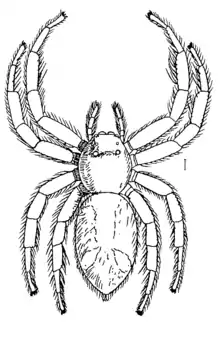Hyllus giganteus
Hyllus giganteus, commonly referred to as the giant jumping spider, is a jumping spider native from Sumatra to Australia.[1][2] It is best known for being the largest jumping spider species known to science, ranging from 1.8–2.5 centimetres (0.71–0.98 in) in length.[3] It is popular among spider hobbyists and breeders as the largest known jumping spider.[4]
| Hyllus giganteus | |
|---|---|
 | |
| Male from Workman, 1896. Specimen from Sulawesi. | |
| Scientific classification | |
| Domain: | Eukaryota |
| Kingdom: | Animalia |
| Phylum: | Arthropoda |
| Subphylum: | Chelicerata |
| Class: | Arachnida |
| Order: | Araneae |
| Infraorder: | Araneomorphae |
| Family: | Salticidae |
| Subfamily: | Salticinae |
| Genus: | Hyllus |
| Species: | H. giganteus |
| Binomial name | |
| Hyllus giganteus Koch, 1846 | |
Discovery
The giant jumping spider was first discovered in 1846 by German arachnologist Carl Ludwig Koch and was first mentioned in his cowritten book The arachnids: depicted and described true to nature.[5][6]
Description
Hyllus giganteus is often confused for other species, especially Hyllus diardi. It can be distinguished by its large size and distinctive stripes at the top of its "face" and black band across the head. It has two white lines running down the sides of its body. Males and females often have different colourations.[7]
References
- "Hyllus giganteus C. L. Koch, 1846". Catalogue of Life. Species 2000: Leiden, the Netherlands. Retrieved 10 March 2021.
- Bern, Natural History Museum. "NMBE - World Spider Catalog". wsc.nmbe.ch. Retrieved 2021-02-26.
- Unplugged, BBC Earth. "Watch the world's biggest jumping spider make a leap". www.bbc.com. Retrieved 2021-02-26.
- "Welcome Sp👀der Lovers". World Of Phids LLC. Retrieved 2021-02-26.
- Bern, Natural History Museum. "NMBE - World Spider Catalog". wsc.nmbe.ch. Retrieved 2021-02-26.
- Koch, C. L.; Hahn, Carl Wilhelm (1831). Die Arachniden : Getreu nach der Natur abgebildet und beschrieben. Nürnberg: In der C. H. Zeh'schen Buchhandlung.
- "Hyllus Diardi Spider: Facts, Identification and Pictures". Spider Identifications. 2019-05-23. Retrieved 2021-05-04.